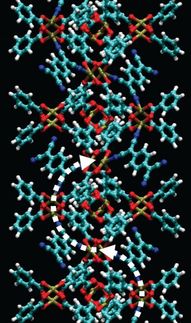Elastic Inks for Textile-Integrated Electronics
Smart textiles with intelligent functions: Electrically conductive prints made from conductive inks are a cost-effective alternative to conductive yarns
Electrically conductive prints on textiles are the basis for functional textiles with electronic functions, so-called smart textiles. Conductive inks and binders must be well matched to ensure permanent conductivity even under external mechanical influences such as stretching, pressure and bending. The German Institutes of Textile and Fiber Research (DITF) are working on new ink formulations that meet these requirements.

Applying the conductive layer with a squeegee
DITF
Sports, fashion and the automotive industry - textiles with integrated electronics are used in many areas of everyday life. Textile-integrated electronics help monitor human vital parameter and performance data, and enable the fashion industry to integrate interactive elements into clothing. It is used in a variety of ways in the automotive industry, where it enhances passenger comfort and safety.
The most common conductive components used in textiles to date are wrapped yarns and tension-relieved conductive yarns arranged in loops. They ensure a reliable flow of electricity even in textiles subject to high mechanical stress. Their production is complex. As a result, they are expensive and only partially suitable for the mass market. Printing conductive structures on textile surfaces using screen printing or chromojet technology, a digital spray printing technique, is much more cost-effective.
However, there are several challenges in producing printed conductive textiles. One of the biggest difficulties is ensuring the conductivity of the printed materials while maintaining the flexibility and softness of the textile. In addition, the durability of the prints can deteriorate, especially with frequent washing or mechanical stress. Stretching or movement can cause the prints to break or tear. Electrical conductivity is often impaired even under low mechanical stress, when the stretching of the conductive layer is not reversible. The adhesion between the print application and the textile can weaken with repeated stretching. This results in poor long-term stability. The integration of electronic elements into textiles is also often hampered by the fact that the connection between the conductive elements and the electronic components is prone to failure.
The DITF are working on new solutions to address these challenges. The Color- and Functional-Printing Working Group is working on new ink and paste formulations based on conductive particles and elastic binders. The aim is to improve the elongation behavior of prints while maintaining good electrical conductivity. The elastic properties of the binder are largely determined by the auxiliaries and additives used. The DITF determine the interactions between these components and derive knowledge for the formulation of new elastic and highly conductive inks.
The hysteresis properties of new ink formulations are of central importance. Hysteresis refers to the ability of a material to maintain its properties under repeated strain or stress. Well-matched hysteresis supports the conductivity of printed structures even under continuous mechanical stress. Suitable materials can adapt to the movement of the textile without compromising the conductive properties.
The goal of the research team at the DITF is to expand the knowledge of the interactions between conductive particles and binders, between additives and textile auxiliaries, in order to produce highly conductive inks and pastes. This will make it possible to produce the best possible and most resistant print coatings for different textile substrates and different applications, enabling reliable conductivity.
Under these conditions, the costs for mass production of textile electronics can be reduced.
Most read news
Topics
Organizations
Other news from the department science

Get the chemical industry in your inbox
By submitting this form you agree that LUMITOS AG will send you the newsletter(s) selected above by email. Your data will not be passed on to third parties. Your data will be stored and processed in accordance with our data protection regulations. LUMITOS may contact you by email for the purpose of advertising or market and opinion surveys. You can revoke your consent at any time without giving reasons to LUMITOS AG, Ernst-Augustin-Str. 2, 12489 Berlin, Germany or by e-mail at revoke@lumitos.com with effect for the future. In addition, each email contains a link to unsubscribe from the corresponding newsletter.





























































